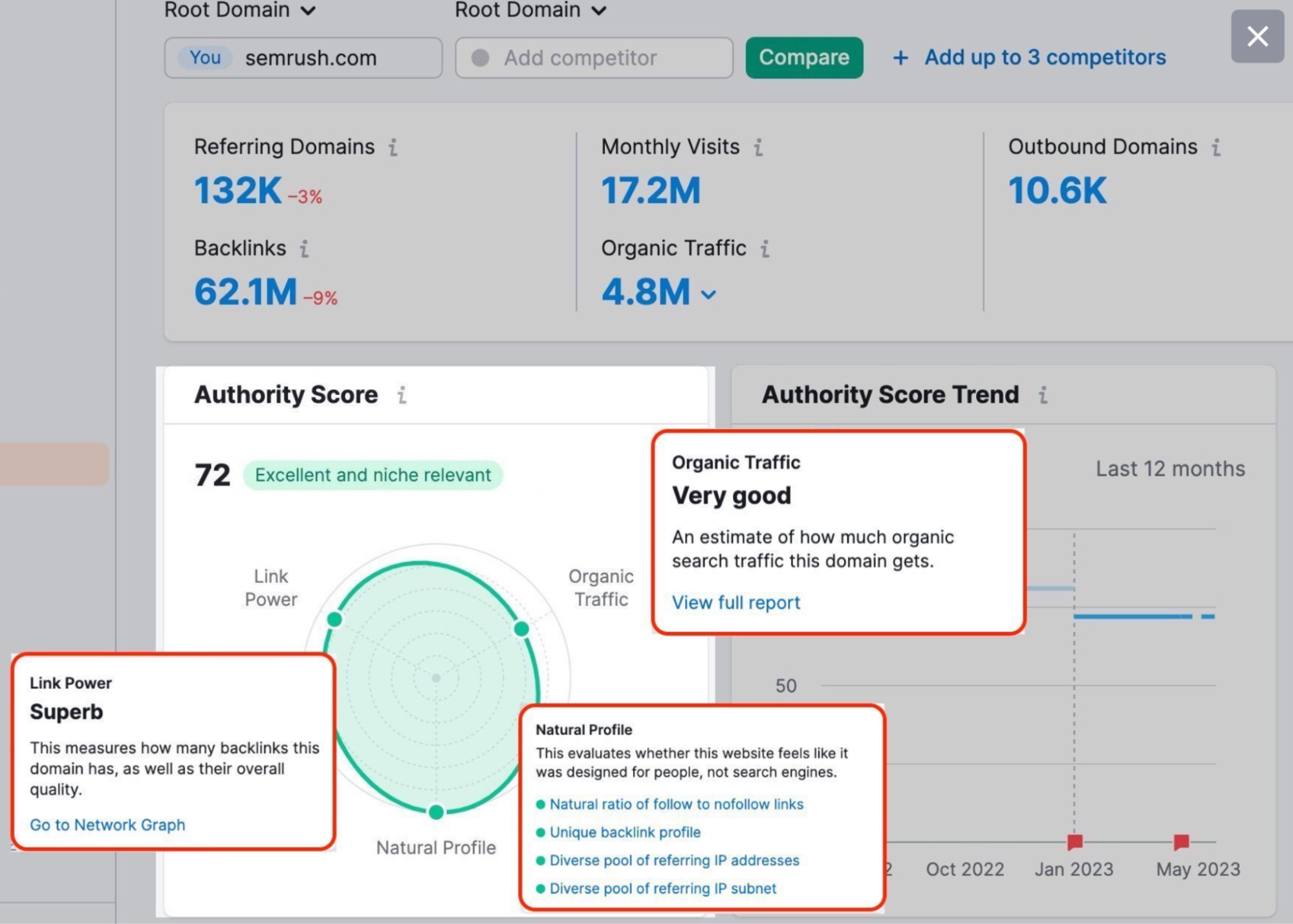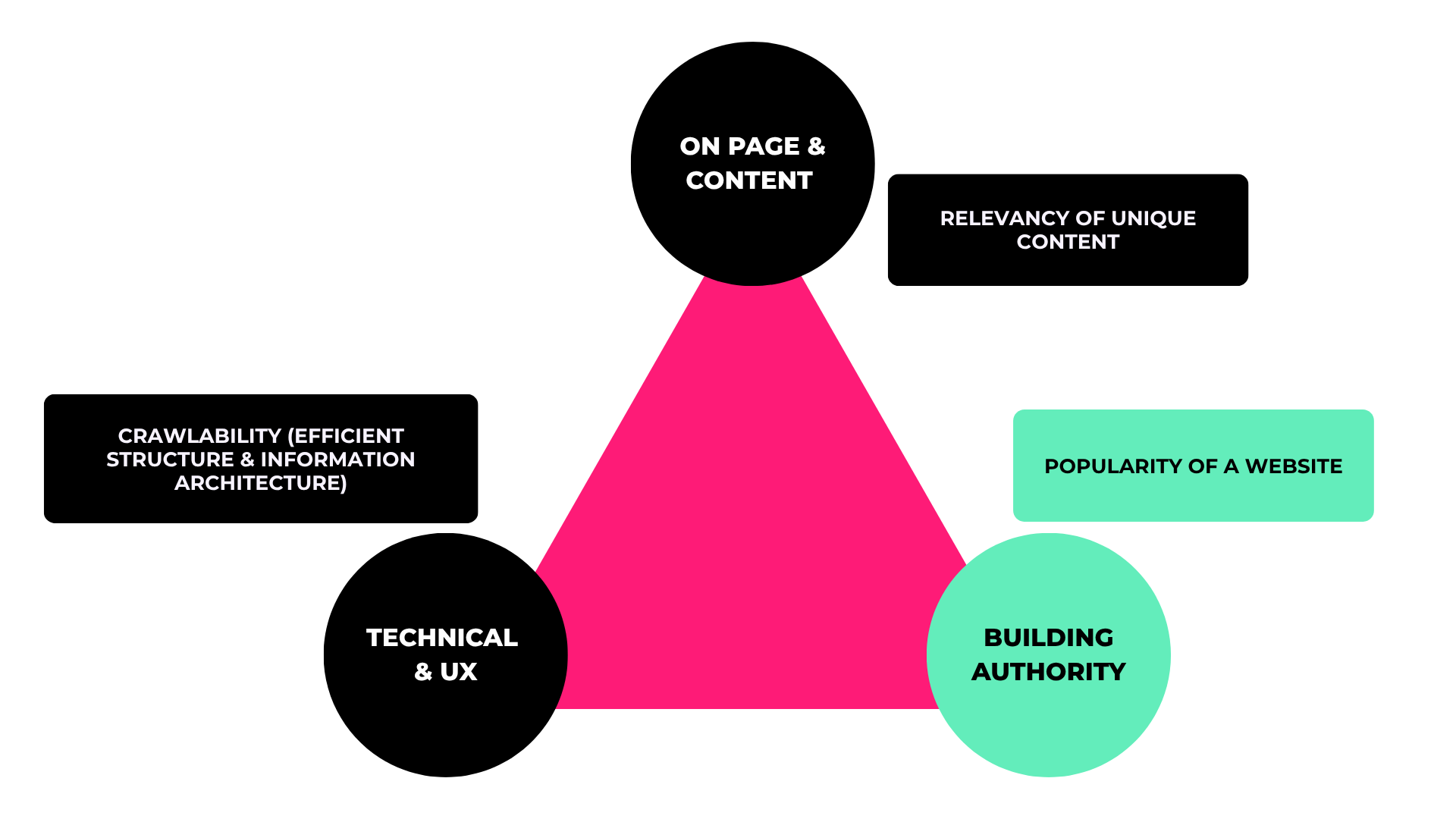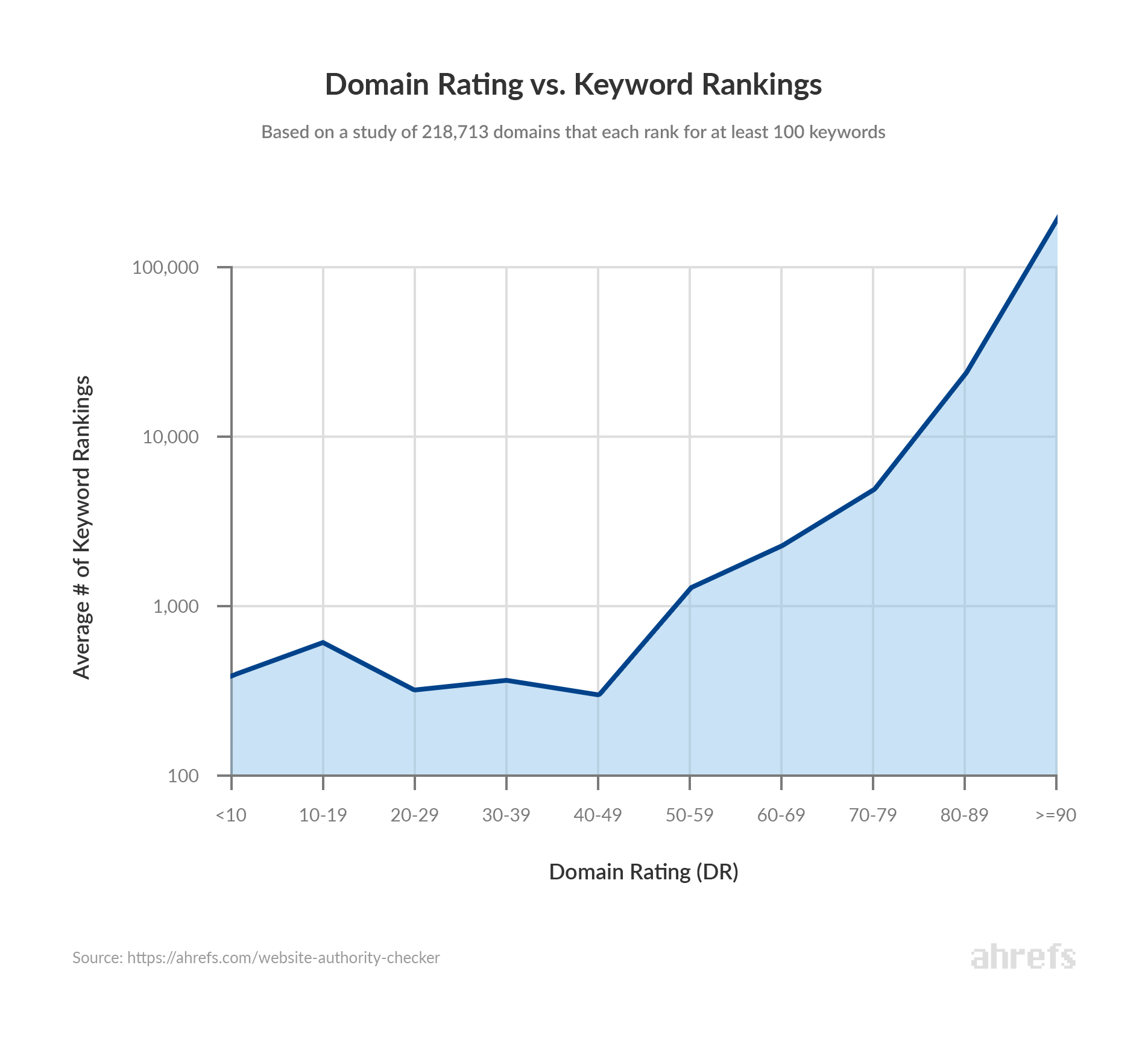Typically when we refer to Domain Authority (or DA), we are talking about a metric that scores a website’s ‘strength’ which predicts how likely a website is to rank on search engine result pages (SERPs). In simple terms, Domain Authority is based on the number of links (i.e. websites that link to yours), and the quality of those links. The score ranges from 1 to 100, with higher scores indicating a stronger likelihood of ranking in more competitive niches.
It's important to note that Domain Authority is not a direct ranking factor used by Google. Google uses its own mix of ranking signals, many of which overlap with DA but are not identical. Domain Authority is therefore a predictive metric that helps marketers gauge their site's strength in comparison to their competitors.
Domain Authority, Authority Score, Domain Rating or Trust Flow?
What’s the difference? As mentioned above, Domain Authority (or any similar term) is not a direct ranking factor, instead it’s a mix of signals to try and predict the strength of a website and therefore the likelihood of how well a website will rank in SERPs.
These scoring systems are typically developed by market-leading SEO software companies, and which score you use depends on which software you rely upon. Note that there is no one ‘best’ score, and because each platform calculates metrics differently, it’s also a good idea to take an average of metrics from all of the different platforms.
All of the below are calculated out of 100, and while the scores may vary from platform to platform, their methods of calculation are broadly speaking quite similar:
- Domain Authority: Moz
- Authority Score: Semrush
- Domain Rating: Ahrefs
- Trust Flow (and Citation Flow): Majestic

Authority Score: Semrush
Checking your Domain Authority is simply a case of having access to one of the above platforms. Comparing these metrics across different tools helps to gain a more comprehensive understanding of a website’s authority and link profile. No single metric tells the whole story, so analysing multiple sources can lead to better SEO decision-making.
How is Domain Authority Calculated?
While Domain Authority and similar metrics are fairly complicated in terms of the way they are calculated, there are a few basic factors that play their part.
At its most basic level, Domain Authority can be broken down as a combination of the following few metrics:
- Number of linking root domains - The count of unique websites linking to your domain.
- The total backlink count - The total number of backlinks to your website.
- The quality of those backlinks - The authority and relevance of the sites linking to you.
Domain Authority is a relative metric rather than an absolute measure, meaning that it’s best used to compare a website's strength against competitors rather than aiming for a perfect score.
Furthermore, DA operates on a logarithmic scale, making it progressively harder to increase at higher levels. In other words, improving a DA score from 10 to 20 is relatively easy, whereas moving from 70 to 80 requires far more effort and higher-quality links.
It’s worth also noting that the number of links is not something to focus on. Quality over quantity absolutely applies in terms of Domain Authority. One link from a higher authority website provides more value than one hundred links from poor quality websites. Plus, you’ll potentially be doing your website some harm if you intentionally chase the number of links rather than the quality of links, which leads nicely onto…
A Short History of Link Building
In the early days of SEO, link building was primarily a numbers game. The more links a website had, the better it ranked. However, this led to widespread manipulation, with websites engaging in excessive link exchanges, directory submissions, and low-quality guest posting.
If you’ve ever seen comments on blog posts where there’s a link within the comment, this was an early SEO tactic to increase the number of links pointing to a website. However, it was quite clearly very easy to manipulate, and so Google made changes to its algorithms to combat this type of web spam.
“PageRank” was introduced in 1998, which emphasised link quality over sheer quantity. Over the years, further major algorithm updates such as Panda (2011) and Penguin (2012) went one step further, penalising sites engaging in manipulative link schemes. Penguin in particular significantly changed link building strategies for SEOs, with some websites being hugely negatively impacted for having chased quantity of links rather than quality of links. In some more severe cases, some websites that were also reliant solely on SEO traffic even went out of business.
By 2015, Google had moved toward a more natural link acquisition approach, favoring websites that earned links through high-quality content, PR efforts, and organic citations. Most of our link building strategies at Reflect Digital have Digital PR as their backbone for this very reason - quality over quantity pays dividends in the long run.
Today, link-building is about acquiring high-quality, relevant backlinks from authoritative sources. Google’s AI-driven updates, and their focus on E-E-A-T, further emphasise content relevance and link context rather than just backlink quantity.
Three Pillars of SEO
How Does SEO Help with Google's Objectives?
 Just increasing your Domain Authority does not necessarily mean you’ll see improvement in your organic rankings. SEO success depends on the three foundational pillars: technical SEO, on-page SEO, and off-page SEO (or link building).
Just increasing your Domain Authority does not necessarily mean you’ll see improvement in your organic rankings. SEO success depends on the three foundational pillars: technical SEO, on-page SEO, and off-page SEO (or link building).
Technical SEO ensures that a website is accessible and efficiently crawlable by search engines. This includes optimising site speed, mobile-friendliness, structured data, and fixing technical issues like broken links and indexation errors. Even the best content won’t rank well if a website has significant technical flaws.
On-page SEO focuses on optimising individual pages for relevant keywords and user experience. This involves writing compelling meta descriptions, using proper heading structures, and ensuring internal linking strengthens the site’s architecture. High-quality, authoritative content that addresses search intent is critical for improving rankings.
Off-page SEO revolves around building a strong backlink profile and digital presence, or in other words as we’re discussing in this article: improving your Domain Authority.
The Three Pillars of SEO are required in order to see success in the long-run: one does not work without the other.
How to Increase Domain Authority
Compare Against Competitors
Rather than focusing on achieving an arbitrary DA score, businesses should compare their website's DA against competitors. If a competitor in the same industry has a DA of 50 while yours is 40, the goal should be to surpass them, not necessarily reach 100.
In more competitive markets, a higher Domain Authority may be required in order to see high rankings. Meanwhile, in more niche markets, a low Domain Authority may work, so long as your content and technical SEO elements are higher quality than your competitors.
Quick Wins
One effective strategy is competitor backlink analysis. Identifying which sites are linking to competitors but not your website can reveal some of the easier opportunities in terms of backlink acquisition. If a website has already linked to several competitors, there can often be little reason for them to not link to your website as well.
Make sure to set up social media accounts, including a link back to your website in your bio, too. Not only does this protect your business by registering the brand name on social media before someone else does, but it’s some of the easiest (and most natural) links that you can create.
Outside of competitor analysis and social media, consider also your strategic partners, existing relationships, partner websites or other obvious website owners. If it would make logical sense for them to link to your website, because of an existing relationship, then these are the easiest links to gain and are impossible for your competitors to copy, too.
Long Term Strategy
Outside of the basic ‘quick wins’ mentioned above, one of the fastest ways to boost DA is by acquiring high-quality backlinks through guest posting, strategic partnerships, and digital PR efforts. Additionally, optimising internal linking helps strengthen website architecture and improve the distribution of link equity.
Fixing broken links, both internally and externally, ensures that existing link value isn’t lost. Creating high-quality, shareable content such as in-depth guides, industry reports, and thought leadership articles can also attract organic links in the long run. Getting featured in industry publications can also enhance credibility and earn authoritative backlinks. Remember that the higher the authority of the website, the more powerful the link is for you.
How Long Does it Take to Increase Domain Authority?
Improving Domain Authority is a long-term process that depends on various factors, including the quality and quantity of backlinks, content strategy, and overall SEO efforts. For new websites with a low DA, noticeable improvements may take several months. Websites with an existing high DA may require years of sustained effort to see significant gains.
Remember that Domain Authority is on a logarithmic scale, meaning the higher the number, the harder it is to improve.
Most SEO tools also only update pages every few weeks, if not months, at best. This means that your newly established links may not ‘show up’ in terms of Domain Authority for several weeks if not months - so, be patient!
What is a Good Domain Authority?
A "good" Domain Authority score depends on the industry, competition, and the nature of the website. Generally speaking, DA scores can be interpreted as follows:
- 1-20: Low authority. These scores are usually found on new or small websites with few backlinks.
- 21-40: Moderate authority scores. Sites within this range are typically small to mid-sized businesses that are still developing their online presence.
- 41-60: Strong authority, which suggests that a website is well-established and has high-quality backlinks.
- 61-80: Very high authority scores. These scores are common among large businesses, media outlets, and authoritative brands.
- 81-100: Exceptional authority. This range is typically reserved for the web's most powerful sites, including Google, Wikipedia, and major news publications.
Instead of focusing on a specific DA score, businesses should benchmark against competitors within their niche. A website’s goal should be to achieve a DA higher than key competitors rather than aiming for an arbitrary number.
 Image Credit: Ahrefs
Image Credit: Ahrefs
Key Takeaways
Domain Authority serves as a great way of predicting a website’s likely ranking potential, but it’s not an official Google ranking factor nor is it a metric that Google uses.
Maintaining a high Domain Authority requires regular high-quality backlink building, strong technical SEO, and authoritative content. Instead of chasing a perfect DA score, businesses should focus on outperforming competitors in their niche.
SEO success depends on balancing technical, on-page, and off-page efforts - there is no one-size-fits-all strategy for SEO, and all three ‘pillars’ are needed to see success. Just improving Domain Authority alone will not see results!
For help with your SEO Strategy, and whether Domain Authority is a metric you should be focusing on, speak to our SEO experts by contacting us today.

MEET THE AUTHOR.
ANDY MOLLISON
Andy drives high-quality, high-converting organic traffic to a wide range of businesses, from local companies to global brands.
A strategic search marketer, Andy’s expertise lies predominantly in e-commerce SEO services, websites and technical SEO, and is particularly adept at finding opportunities to provide quick wins and long-term return on investment.
More about Andy























